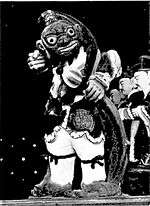Misin tapa undong

| Part of a series on |
| Korean shamanism |
|---|
 |
|
Sub-movements |
|
Related religions |
The "movement to destroy the worship of gods" (Hangul: 미신 타파 운동 misin tapa undong, also "to defeat the worship of gods"), also described as "movement to destroy superstition", as 미신 misin is often translated after the movement, comprises a series of waves of "demonisation" and forceful eradication of Korean shamanism, folk religion, and mythology that took place in the period between the late 19th century and the 1980s.[1] It started in the 1890s with the rise of influence of Protestant missionaries,[2] and culminated with the "gods' worship destruction movement" that formed within the New Community Movement of the 20th century, in South Korea, which physically destroyed most of the indigenous cults, which were replaced by Christianity.[3]
Late Joseon (1890s)
Protestant missionaries showed in dark light, as "devil worship", Korean indigenous religions and mu (shamans) since the 19th century.[4] The missionaries reported of "fetish" burnings, great bonfires of ancestral tablets, shamans' tools and clothes, and harborages of spirits that were "destroyed as were the books in Ephesus".[5] They circulated stories of shamans converted to Christianity who encouraged themselves the destruction of the ancestral religion.[6] The exorcistic struggle between a shaman and a Christian even became a literary motif with Kim Tongni's colonial-period novella Portrait of a Shaman.[7]
Missionaries found allies in the Korean intellectuals of the twilight years of the Joseon kingdom, producing together the Independent (Tongnip Sinmun), the first newspaper published in Korean language.[8] The newspaper promoted iconoclasm and addressed government officials on the necessity to eradicate the indigenous religion.[9]
In 1896 the police began to arrest shamans, destroy shrines and burn ritual paraphernalia, acclaimed by the Independent.[10] At one point the Independent also criticised Buddhist monks.[11]
Japanese rule (1910-1945)
Campaigns against traditional Korean religion also accompanied Japan's annexation of Korea, the Japanese having already equated secularisation with modernity at home.[12] The colonial police harassed and sometimes arrested the mu, but under Japanese rule the policy towards Sinism was neither monolithic nor consistent.[13]
Following the rhetoric of the Independent of the generation past, the colonial government portrayed the indigenous religion and shamans as irrational and wasteful, adding the notion that they were also unhygienic.[14] Urban people adopted this rhetoric as a self-conscious ideology, seeking to distinguish themselves from their own rural origins.[15] Migrants to the cities took up this new worldview, also refusing gut healing and traditional medicine.[16]
This new paradigm would have become central in the rural development projects of independent South Korea.[17]
Yi Seungman period (1948-1960)
Under Yi Seungman's government, Protestant Christians living in Jeju Island led a "campaign against gods", where they sought to uproot Jeju Sinism and its pantheon of 18,000 deities.
New Community Movement (1970s)

In the 1970s the president Park Chung-hee initiated the New Community Movement (Saemaul Undong), a mass mobilisation intended to transform rural society in both form and spirit.[18] This was similar to the Cultural Revolution in communist China which happened at the same time.
Under the reform banner, a formal "Movement to Destroy the Worship of Gods" (Misin Tapa Undong), or "Anti-Superstition Movement" as usually translated, was started. With official encouragement, police and local leader suppressed gut rites and local cults.[19][20][21]
The movement's agents poured gasoline on village shrines and torched them, destroyed sacred trees, totem poles, and cairns, raided gut and arrested shamans.[22] Contemporary commentors criticise the movement for having damaged the Sinist tradition and having caused much of the South Korean population to adopt the foreign Christian religion.[23]
Legacy
The Korean indigenous religion was greatly weakened. Since the 1980s the traditional religion and shamans have experienced a modest revival in South Korea in the name of national sentiment.[24] Since the 1990s shamans started to be regarded as "bearers of culture".[25] Only in the most recent times the traditional religion of Korea has come to be recognised as a legitimate "religion" (Mugyo, Muism, the "mu-religion), and the notion of shamanism as the original religion of the Koreans is now pervasive.[26]
See also
References
- ↑ Kendall, 2010. pp. 4-7
- ↑ Kendall, 2010. pp. 4-7
- ↑ Kendall, 2010. p. 10
- ↑ Kendall, 2010. pp. 4-7
- ↑ Kendall, 2010. p. 5
- ↑ Kendall, 2010. p. 5
- ↑ Kendall, 2010. p. 6
- ↑ Kendall, 2010. p. 7
- ↑ Kendall, 2010. p. 7
- ↑ Kendall, 2010. p. 8
- ↑ Kendall, 2010. p. 8
- ↑ Kendall, 2010. p. 8
- ↑ Kendall, 2010. p. 8
- ↑ Kendall, 2010. p. 9
- ↑ Kendall, 2010. p. 9
- ↑ Kendall, 2010. p. 9
- ↑ Kendall, 2010. p. 10
- ↑ Kendall, 2010. p. 10
- ↑ Kendall, 2010. p. 10
- ↑ http://www.koreana.or.kr/months/news_view.asp?b_idx=2244&lang=en&page_type=list
- ↑ http://www.koreana.or.kr/months/news_view.asp?b_idx=2243&lang=en&page_type=list
- ↑ Kendall, 2010. p. 10
- ↑ Kendall, 2010. p. 10
- ↑ Kendall, 2010. p. 11
- ↑ Kendall, 2010. p. 22
- ↑ Kendall, 2010. pp. 29-30
Sources
- Laurel Kendall. Shamans, Nostalgias, and the IMF: South Korean Popular Religion in Motion. University of Hawaii Press, 2010. ISBN 0824833988